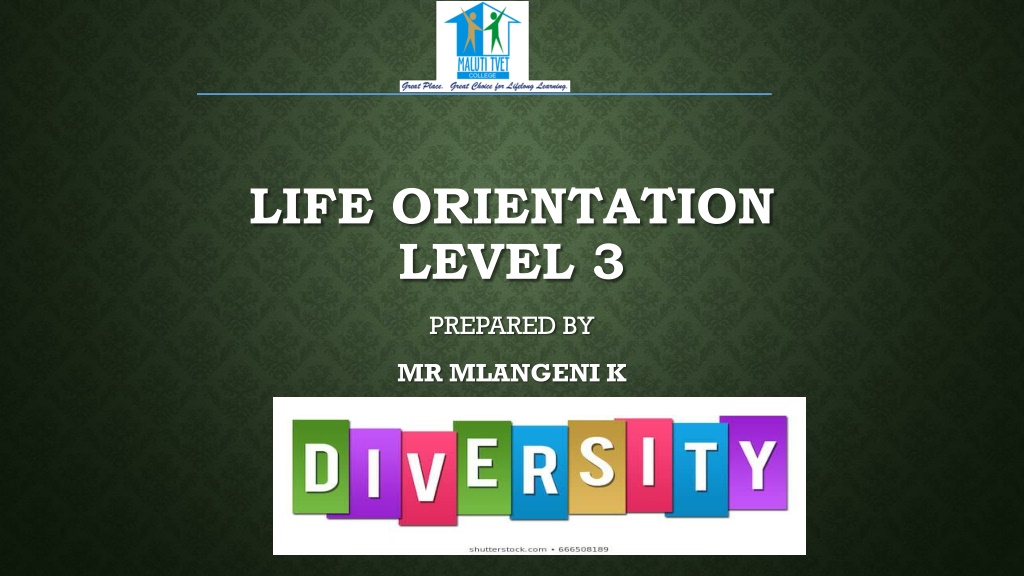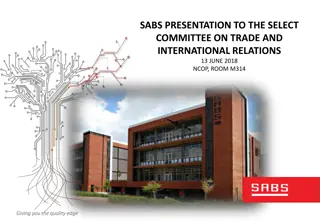Understanding Diversity and Culture in South Africa
Exploring the rich diversity and cultural heritage of South Africa, this content delves into the significance of respecting diversity in the classroom and workplace. It highlights the various ethnic groups, languages, and cultural expressions that contribute to the unique identity of the 'Rainbow Nation'. The narrative emphasizes the importance of embracing diversity and combatting discrimination, racism, prejudice, and stereotyping in a multicultural society.
Download Presentation

Please find below an Image/Link to download the presentation.
The content on the website is provided AS IS for your information and personal use only. It may not be sold, licensed, or shared on other websites without obtaining consent from the author. Download presentation by click this link. If you encounter any issues during the download, it is possible that the publisher has removed the file from their server.
E N D
Presentation Transcript
LIFE ORIENTATION LEVEL 3 PREPARED BY MR MLANGENI K
AFTER COMPLETING THIS LESSON, YOU WILL BE ABLE TO: Describe the concepts diversity and culture and provide examples Explain the benefits of respecting diversity in the workplace and give examples of how respect can be shown Describe the concepts discrimination , racism , prejudice and stereotyping
WHAT IS DIVERSITY? Broadly speaking, diversity refers to a state in which there are many different forms present. This could be in terms of people, ideas, preferences, styles, etc. In a classroom setting, diversity can present itself in a number of different ways: multicultural students, different learning styles, distinct personalities, etc. The teacher is tasked with encouraging and maintaining that diversity. This is one of the many ways in which classroom settings are the perfect place for students to learn invaluable lessons. Diversity encompasses the many differences present in human beings. It is a term that may hold different meanings for different people, and one which has numerous applications. In today s schools, many different elements of diversity present themselves. These include race, socio-economic status, gender, ethnicity, religious beliefs, etc.
South Africa, called by some people the 'Rainbow Nation', a title that captures its diversity and 11 official languages. September is since 1994 officially heritage month, when the histories and cultural practices of all its peoples are celebrated and due recognition given to the men and women who have contributed to the heritage and culture of the nation. Freedom of cultural, religious and linguistic expression is enshrined in the Constitution of the Republic of South Africa. South Africa is a country where creative expression flourishes and its cultural diversity are embodied in its arts and culture.
POPULATION The Black population of South Africa is separated into four major ethnic groups: namely, the Nguni groups which consist of Zulu, Xhosa, Ndebele and Swazi peoples; the Sesotho-Setswana groups, the Shangaan-Tsonga groups, and the Venda groups. The majority of the White population (about 60%) is Afrikaans speaking, and the remaining 40% are English speakers. Three million people, designated as Coloureds, have a mixed lineage, which often consists of indigenous Khoisan people.
LANGUAGE AND CULTURE There are eleven official languages in South Africa. These are English (9.6%), Afrikaans (13.5%), Ndebele (2.1%), Sepedi/Northern Sotho (9.1%), Xhosa (16%), Venda (2.4%), Tswana (8%), Southern Sotho (7.6%), Zulu (22.7%), Swazi or SiSwati (2.5%) and Tsonga (4.5%). Much of the country s regional media use the vernacular when possible. South Africa also recognises other non-official languages such as South African sign language, Khoi-Khoi and the San. Many other languages from all over the world are spoken here too, including Portuguese, Greek, Italian, French, and Chinese.
CULTURAL FOODS South Africa s cultural diversity is expressed in a number of ways; one of the most famous is the different cultural influence that goes into the food that people eat. Maize meal porridge and meat, accompanied by a variety of vegetables such as cabbage, onions, beetroot, carrots, potatoes and morogo (indigenous spinach), amongst others, are food favoured by most Black South Africans. In rural communities, people gather weeds such as blackjack, purslane, pigweed, thistle or goosefoot and many others and turn them into tasty stews. The Venda, Shangaan and Northern Sotho (Bapedi) people enjoy mashonzha, also known as Mopani worms. They are found in and around Mopani trees in the Lowveld areas of Mpumalanga and the Limpopo Provinces. They are fried, grilled or cooked, and spiced with chilli. Food such as curries, meat or vegetable is served with rice, roti or naan (home made breads) are foods favoured by Indians.
CULTURAL FOODS The Khoi and San people enjoy a surprisingly varied menu of edible roots, leaves, plants, berries and nuts gathered from the "veld" (field). They gather eggs, being particularly fond of ostrich eggs. They also hunt for meat such as antelope, birds and small animals. The traditional Xhosa menu is called umngqusho , which is made with samp (crushed dried maize kernel), beans, butter, onions, potatoes, chillies and lemons. South African s love to braai and is very popular way of entertaining.
MUSIC AS AN EXPRESSION OF CULTURE South African music speaks volumes about its ability to celebrate all aspects of its diverse culture. Firstly, is the multilingual national anthem, Nkosi Sikelel iAfrika . Elsewhere in South Africa, people play kwaito (African house music), jazz, hip hop, Afrikaans rock, African gospel, classic rock, pop, traditional drums, Afrikaans sakkie sakkie, and many more. Zulu dance involves high stepping and stomping the ground in rhythm. Dancers hold weapons and shields with their hands raised high. The dancers kick over their head and fall to the ground in a crouch position. In Zulu dances, ankle rattles, shields, headdresses and belts are used as props and to differentiate social class and societal roles.
MUSIC AS AN EXPRESSION OF CULTURE Xhosa traditional music places a strong emphasis on group singing and handclapping as accompaniment to dance. Drums are used occasionally, and they are not musical expression as they are for other South African ethnic groups. Other instruments used by Xhosa people are mouth harps, rattles, whistles, flutes, and stringed-instruments constructed with a bow and resonator.
TRADITIONAL CLOTHING Traditional clothes are one of the most creative forms of expression and one where South Africans love to show their diverse culture. Traditional Zulu dress code is animal skin for men and skirts decorated with hardwood beads for women. The Indian ethnic clothes are dhoti, kurta, and salwar kameez, sari, turban and sherwani for men. Xhosa dress includes intricately sewn designs on blankets that are worn by both men and women as shawls or capes. The other symbol that explains the Xhosa tradition is face-painting by women. For the Xhosa people, face painting allegedly improves beauty and in fact no traditional attire is complete without it. The dots and painting can be found on the face, arms and legs, depending on the style of the dress that is worn. The Tswana dress in traditional animal skins, communicate themes of nature and imitate animals through dance, clapping and song. The women clap and sing to help the dancers reach a trance and soon the dance becomes frenetic. The Basotho people wear seshweshwe, which are colourful German-print clothes, and the men wear blankets.
WHAT IS DIVERSITY IN THE WORKPLACE? Diversity in the workplace means that a company employs a wide range of diverse individuals. In other words, a diverse workforce includes people with different characteristics. Diversity in the workplace means that a company s workforce includes people of varying gender, age, religion, race, ethnicity, cultural background, sexual orientation, religion, languages, education, abilities, etc.
WHAT ARE THE BENEFITS OF DIVERSITY IN THE WORKPLACE?
WORKPLACE DIVERSITY benefit #2: Increased creativity benefit #1: Variety of different perspectives Diversity in the workplace ensures a variety of different perspectives. Diversity in the workplace leads to increased creativity. Since diversity in the workplace means that employees will have different characteristics and backgrounds, they are also more likely to have a variety of different skills and experiences. People with different backgrounds tend to have different experiences and thus different perspectives. Exposure to a variety of different perspectives and views leads to higher creativity. Consequently, employees in a company with higher workplace diversity will have access to a variety of different perspectives, which is highly beneficial when it comes to planning and executing a business strategy. When you put together people who see the same thing in different ways, you are more likely to get a melting pot of fresh, new ideas, thus improving the creativity of your workforce.
benefit #3: Higher innovation benefit #4: Faster problem-solving Companies with higher workplace diversity solve problems faster. Diversity in the workplace leads to higher innovation rate. Harvard Business Review found diverse teams are able to solve problems faster than cognitively similar people. In a diverse workplace, employees are exposed to multiple perspectives and worldviews. When these various perspectives combine, they often come together in novel ways, opening doors to innovation. Employees from diverse backgrounds have different experiences and views, which is why they are able to will bring diverse solutions to the table. Thus, the best solution can be chosen sooner, which leads to faster problem-solving.
benefit #6: Increased profits benefit #5: Better decision making Companies with greater workplace diversity achieve greater profits. Workplace diversity leads to better decision making results. Companies with a diverse workforce make better decisions faster, which gives them a serious advantage over their competitors. As a result, companies with diversity in the workplace achieve better business results and reap more profit. When employees with different backgrounds and perspectives come together, they come up with more solutions, which leads to the more informed and improved decision-making processes and results.
benefit #7: Higher employee engagement benefit #8: Reduced employee turnover Workplace diversity is beneficial for employee retention. Workplace diversity leads to higher employee engagement. Companies with a diverse workforce are generally more inclusive of different individual characteristics and perspectives. The link between workplace diversity and employee engagement is pretty straightforward - when employees feel included, they are more engaged. Diversity and inclusion in the workplace cause all employees to feel accepted and valued. When employees feel accepted and valued, they are also happier in their workplace and stay longer with a company. As a result, companies with greater diversity in the workplace have lower turnover rates.
benefit #10: Improved hiring results benefit #9: Better company reputation Workplace diversity boosts the company s reputation and brand. Workplace diversity leads to better hiring results. Companies that are dedicated to building and promoting diversity in the workplace are seen as good, more human and socially responsible organizations. Diversity in the workplace boosts a company s employer brand and presents a company as a more desirable place to work. Workplace diversity is an especially beneficial asset for attracting top talent from diverse talent pools. Workplace diversity also makes your company look more interesting. Finally, if you present a diverse workforce, you will make it easier for many different people to relate to your company and your brand, opening doors to new markets, customers and business partners. According to a survey conducted by Glassdoor, 67% of job seekers said a diverse workforce is important when considering job offers.
PREJUDICE, STEREOTYPE, DISCRIMINATION AND RACISM This is Eddie. He's a vegetarian. This is Eddie's co-worker Jeff. There are few things in life that he loves more than a hamburger. When Jeff and Eddie meet, they have all sorts of ideas about each other. Some of them are true, and some are just based on stereotypes and prejudice. People belong to certain groups. Whether that group is racial, gender-based, or something like what a person chooses to eat, everyone belongs to at least one group. Being part of a group is not all that there is to a person. For example, Eddie isn't just a vegetarian, he loves rock music and plays in a band on the weekends. But sometimes, people can be judged based on the fact that they are in a group. For example, Jeff thinks that vegetarians all listen to sitar music and nothing else. But Eddie isn't even sure what a sitar is! Let's look closer at how people judge others based on their group affiliation through stereotypes, prejudice, and discrimination.
STEREOTYPES So, Jeff thinks that vegetarians like sitar music. He has a picture in his head about what a vegetarian is like, and sitar music is included in it. A belief about a certain group of people is called a stereotype. Stereotypes can be positive or negative, but are usually an exaggerated idea of what a group is like. For example, Jeff thinks that vegetarians are healthy and peace-loving. Those are positive stereotypes because they reflect well on the group. On the other hand, he also thinks that vegetarians are pedantic and holier-than-thou, which are negative stereotypes. Eddie thinks that meat eaters are all strong, due to all the protein they eat - that's a positive stereotype. But he also thinks that they don't care about the environment, which is a negative stereotype. Both positive and negative stereotypes can have a negative effect on a person. For example, one racial stereotype is that Asian students are really good at math. This is a positive stereotype, but it can make an Asian student feel pressure and feel like a failure if he isn't good at math, which is a negative outcome.
PREJUDICE Stereotypes are exaggerated beliefs about a group of people. But, what happens when someone takes it a step further and applies the stereotype to a specific person? Prejudice is a feeling towards a person based on their affiliation with a group. For example, Eddie thinks that meat eaters don't care about the environment, which is (as we've already seen) a stereotype. But if he decides that he doesn't like Jeff just based on the fact that Jeff eats meat, then he is being prejudiced. His feeling of dislike, which springs from his belief in a negative stereotype, is prejudice. As with stereotypes, prejudice can be either positive or negative. For example, Jeff can decide that he really likes vegetarians or he can decide that he really doesn't like vegetarians. If he likes them, it is a positive prejudice, whereas if he doesn't like them, it is a negative prejudice.
WHAT IS RACISM? Racism is an ugly word that has been around as long as humankind itself. Racism actually can be broken down into two distinct definitions: on the one hand it simply means that groups of people are defined by their inherent differences (skin colour, culture, appearance) and that, because of these differences, one group is seen to be better than the other. The second definition of racism is the unfair treatment of others based solely on these differences. Throughout history, humankind has treated others with contempt and committed atrocities upon them just because of the colour of their skin or the culture from which they come. The most prominent example to most of us would be the plight of the African Americans. From the time of slavery in America, through even today, African Americans have been treated poorly just because of their different-coloured skin. During the times of slavery, Africans were bought and sold like cattle. They were often separated from their loved ones, beaten, and even murdered according to the whims of their 'masters,' the slave owners. After slavery was abolished, African Americans were still seen as less than human (Africans were considered to be only 3/5 human) when it came to taxation and certain rights. In the early 20th century, African Americans began to see improvements with the rise of the Civil Rights Movement. Names such as Rosa Parks, Martin Luther King, Jr. and Malcolm X immediately come to mind as forerunners in this crusade for equality among African Americans.
EDUCATION IS THE MOVEMENT FROM DARKNESS TO LIGHT























